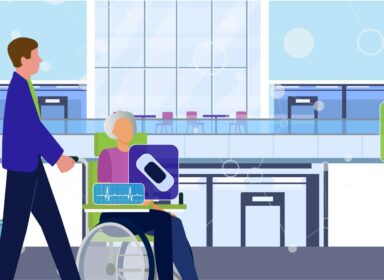Telehealth has transformed the convenience of healthcare delivery, but its transformative potential is so much bigger than that. It has the potential to bring high quality care to areas where it was never before available, such as in rural areas where healthcare access is limited. Unfortunately, connectivity remains a primary obstacle to making telehealth access truly universal.
In this blog post, we will discuss the current digital divide, how expanding telehealth access can improve care quality and decrease costs in rural areas, and why virtual telemetry is central to unlocking the full potential of telehealth in rural areas and beyond.
The Digital Divide in Internet Access
In 2021, the Bipartisan Policy Center released a survey noting that 45% of American adults say access to technology like broadband and computers is a barrier when it comes to telehealth. The noted lack of access predominately impacted rural residents and patients over 65.
The chasm between those who have strong technology and internet access and those who do not is widely referred to as the “digital divide.” When it comes to healthcare, the digital divide means the inability to access virtual care. Currently, two-way video calls, which are the standard of care in telehealth, require household connections capable of delivering 100/20 Mbps. However, more than one third of rural residents reported that they couldn’t achieve this through the right devices and high-speed internet access. The need for strong connectivity applies to many remote monitoring devices as well. These devices are essential to providing remote care clinicians the data they need to make informed decisions and diagnoses.
According to a recent article, legislators, care providers, and insurers believe that expanded telehealth access can cut millions in rural health costs, and are actively working to close the digital divide so that its potential can be realized. For example, the federal Affordable Connectivity Program helps patients access internet service and offers discounts on electronics that can be used for telehealth. Additionally, the Rural Health Information Hub keeps a list of grants and other funding opportunities for broadband access in rural communities.
Bridging the Divide to Provide Quality Care, Anywhere
Many households in rural areas do not have access to internet speeds fast enough to take advantage of telehealth visits. And yet, the use case for telehealth is even more compelling and urgent in these areas. Inhabitants of rural areas have limited care options. General doctors and hospitals are often a long car ride away, and specialists may be unreachable altogether. Telehealth can minimize in-person trips to run diagnostic tests that can be conducted remotely, replace physical check-ins for the standard management of chronic conditions, and reduce non-emergency trips to the ER by first consulting with a clinician remotely.
For patients with chronic conditions, remote monitoring has the potential to improve outcomes, avoid complications, and reduce the number of people being readmitted to the hospital each year. Pre-COVID, chronic conditions accounted for more than $8 billion in avoidable emergency visits, and that number has only grown with time.
In addition, telehealth can provide additional care choices to citizens of rural areas. The ability to select a specialized and well-regarded healthcare provider is essential, particularly in the diagnosis and treatment of more complex conditions and rare disease. With the obstacle of proximity minimized, patients can choose a provider on the basis of their reputation and expertise.
Minimizing Rural Health Costs with Telehealth
In addition to its impact on care access, utilizing telehealth can save time and money for patients, which has the potential to reduce the financial burden of treatment for diagnoses like cancer or chronic conditions like asthma and diabetes. The costs associated with traveling to specialists can add up, particularly for conditions that require frequent check-ins.
A recent report by the Southern Rural Black Women’s Initiative for Economic and Social Justice examined common health issues, including diabetes, chronic respiratory diseases, heart disease, heart failure, and cancer in various counties in the rural southern U.S. The findings showed that widening telehealth access through broadband improvements in the southern U.S. could result in nearly $43 million in healthcare cost savings.
Virtual Telemetry: A Central Tenet of Virtual Healthcare
Two-way video calls are fundamental to enabling remote virtual interactions between patient and doctor, but they aren’t the only technology needed to enable telehealth. Equally central to the success of virtual care models is virtual telemetry, which enables providers to accurately monitor a variety of indicators from afar. The quality and acuity of this data continues to improve, particularly in areas like cardiac monitoring where it can be used to assess a variety of complex conditions.
Through an innovative virtual telemetry solution like InfoBionic’s MoMe™ ARC Platform, providers can extend hospital grade monitoring from nearly anywhere, and patients can embrace virtual monitoring confidently with solutions that are convenient, intuitive, and marked by quality data. Data can be transmitted in real-time and stored securely in the cloud where providers can use it to diagnose and intervene more proactively than ever before.
Internet connectivity is fundamental to both telehealth and remote patient monitoring. By closing the digital divide and embracing new and innovative ways to diagnose and deliver care outside the office, we will collectively enhance care quality and cost effectiveness everywhere—even in the most rural locations.
Contact us to learn how a solution like the MoMe™ ARC platform can empower rural regions’ remote access to healthcare.


